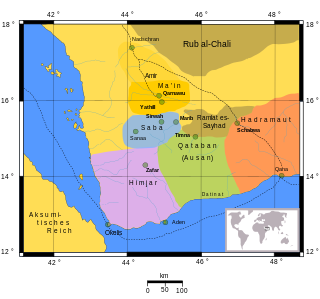
Sheba, or Saba, was an ancient South Arabian kingdom in modern-day Yemen whose inhabitants were known as the Sabaeans or the tribe of Sabaʾ which, for much of the 1st millennium BCE, were indissociable from the kingdom itself. Modern historians agree that the heartland of the Sabaean civilization was located in the region around Marib and Sirwah. In some periods, they expanded to much of what is now modern-day Yemen and even parts of the Horn of Africa, in modern-day Ethiopia. The spoken language of the Sabaeans was Sabaic, a variety of Old South Arabian.
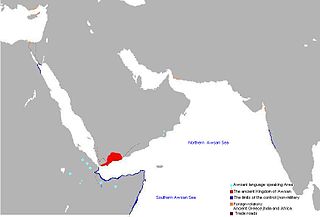
The Kingdom of Awsan, commonly known simply as Awsan, was a kingdom in Ancient South Arabia, centered around a wadi called the Wadi Markha. The wadi remains archaeologically unexplored. The name of the capital of Awsan is unknown, but it is assumed to be the tell that is today known as Hagar Yahirr, the largest settlement in the wadi. Hagar Yahirr was 15 hectares and surrounded by an irrigated area of nearly 7,000 hectares, indicating that it was a formidable power in its time. The main god of Awsan was called Balu (blw).
Šamsi was an Arab queen who reigned in the Ancient Near East, in the 8th century BCE. She succeeded Queen Zabibe. Tiglath-Pileser III, son of Ashur-nirari V and king of Assyria, was the first foreign ruler to bring the Arabs under his control. When Šamsi rebelled against him by joining an alliance forged by Rakhianu of Damascus, Pileser attacked and defeated Samsi, made her and her alliance partners surrender, and pay a tribute to remain in power. She ruled for 20 years and her successor was Queen Iatie, in about 700 BC.

Pre-Islamic Arabia is the Arabian Peninsula and its northern extension in the Syrian Desert before the rise of Islam. This is consistent with how contemporaries used the term Arabia or where they said Arabs lived, which was not limited to the peninsula.
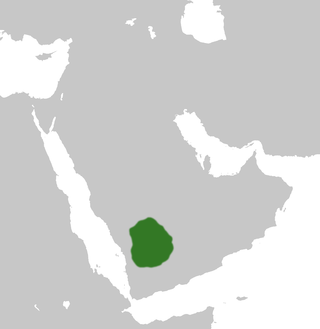
Ma'in was an ancient South Arabian kingdom in modern-day Yemen. It was located along the strip of desert called Ṣayhad by medieval Arab geographers, which is now known as Ramlat al-Sab'atayn. Wadd was the national god of Ma'in. The spoken language was Minaic. The kingdom appears in the historical record in the 8th century BCE, and transition from a city-state to kingdom in the last quarter of the 7th century BCE. The date of the end of Ma'in is heavily disputed, but the most popular hypothesis places its demise in the 1st century CE.

The ancient history ofYemen or South Arabia is especially important because it is one of the oldest centers of civilization in the Near East. Its relatively fertile land and adequate rainfall in a moister climate helped sustain a stable population, a feature recognized by the ancient Greek geographer Ptolemy, who described Yemen as Eudaimon Arabia meaning Fortunate Arabia or Happy Arabia. Between the eighth century BCE and the sixth century CE, it was dominated by six main states which rivaled each other, or were allied with each other and controlled the lucrative spice trade: Saba', Ma'īn, Qatabān, Hadhramaut, Kingdom of Awsan, and the Himyarite Kingdom. Islam arrived in 630 CE and Yemen became part of the Muslim realm.

Shammar Yahr'ish al-Himyari, full name Shammar Yahr'ish ibn Yasir Yuha'nim al-Manou was a Himyarite king. He was the first to have the title “King of Saba', Dhu Raydan, Hadramawt and Yamnat” and he united most of Yemen during his rule.
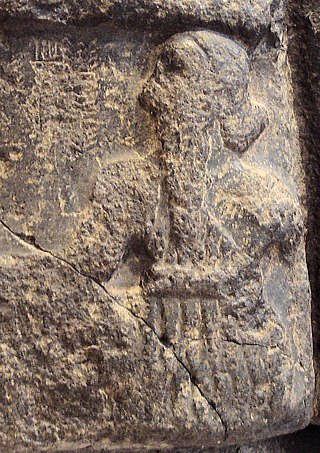
Sargon of Akkad, also known as Sargon the Great, was the first ruler of the Akkadian Empire, known for his conquests of the Sumerian city-states in the 24th to 23rd centuries BC. He is sometimes identified as the first person in recorded history to rule over an empire.

The Qedarites were an ancient Arab tribal confederation centred in their capital Dumat al-Jandal in the present-day Saudi Arabian province of Al-Jawf. Attested from the 9th century BC, the Qedarites formed a powerful polity which expanded its territory throughout the 9th to 7th centuries BC to cover a large area in northern Arabia stretching from Transjordan in the west to the western borders of Babylonia in the east, before later consolidating into a kingdom that stretched from the eastern limits of the Nile Delta in the west till Transjordan in the east and covered much of southern Judea, the Negev and the Sinai Peninsula.
Kaminahu is the name of an ancient South Arabian city in the northern al-Jawf region of present day Yemen, 107 km north-east of Sana'a at about 1100 meters above sea level.
Haram is an ancient city in the north of al-Jawf in modern-day Yemen, at about 1100 metres above sea level. It is bordered by the Yemen Highlands to the north, in the west by the ancient Kaminahu, in the east by the ancient Qarnāwu, and in the south by the Ghayl, otherwise known as the village of al-Ḥazm.

Sirwah was, after Ma'rib, the most important economical and political center of the Kingdom of Saba at the beginning of the 1st century BC, on the Arabian Peninsula. Ṣirwāḥ was surrounded by a fortified wall. The city layout inside the oasis included a number of large buildings. It’s also a part of Khawlan.

Karibʾīl Watār Yahanʾm, sometimes distinguished as Karib'il Watar II, was probably the most important ruler of the early days of the Sabaean Kingdom. He is sometimes regarded as the founder of the kingdom proper, as he was responsible for changing the ruler's title from ("Mukarrib") to "king" (malik).

The Sargonid dynasty was the final ruling dynasty of Assyria, ruling as kings of Assyria during the Neo-Assyrian Empire for just over a century from the ascent of Sargon II in 722 BC to the fall of Assyria in 609 BC. Although Assyria would ultimately fall during their rule, the Sargonid dynasty ruled the country during the apex of its power and Sargon II's three immediate successors Sennacherib, Esarhaddon and Ashurbanipal are generally regarded as three of the greatest Assyrian monarchs. Though the dynasty encompasses seven Assyrian kings, two vassal kings in Babylonia and numerous princes and princesses, the term Sargonids is sometimes used solely for Sennacherib, Esarhaddon and Ashurbanipal.
Karibi-ilu was a Mukarrib of Saba' who reigned from 700 BC to 680 BC. The name Karibi-ilu in Akkadian matches "Karab-El Bayin" in Sabaean, combined of "KRB-El" which means one who carries out the instructions of El and "BYN" one who removes punishment.
Ilīsharaḥ Yaḥḍub was a king of Saba' who reigned from 120 till 130 CE. At the very beginning of the second century CE, the territory of Sabaʾ was under the control of the Ḥimyarite king ʿAmdān Bayyin Yuhaqbiḍ. In the meantime, Ilīsharaḥ Yaḥḍub prince (qayl) of the tribe of dhū-Shibāmum, fraction of Bakil, rose up against the kingdoms of Qatabān, Ḥimyar, Ḥaḍramawt, and the principality of Radmān and claimed the title of “King of Sabaʾ and dhū-Raydān”. He ruled over a newly independent Sabaean kingdom, with the support of families belonging to the old Sabaean aristocracy of Maʾrib and tribes from the western highlands: Dhamarī, Maʾdhinum , Ḥāshidum, dhū-Hagarum .
Nashshan is the name of an ancient South Arabian city in the northern al-Jawf region of present day Yemen, originally independent but later subsumed into the territory of the ancient Kingdom of Ma'in between the 6th and 4th centuries BC. Like many other city-states of the Jawf, Nashshan functioned as the name of both the city and the tribe.
Sumuhu'ali Yanuf I. Mebiy was a Sabaean, ruler (Mukarrib) of the ancient South Arabian kingdom of Saba. He was son of the powerful ruler Yada'il Dharih and is known from inscriptions.
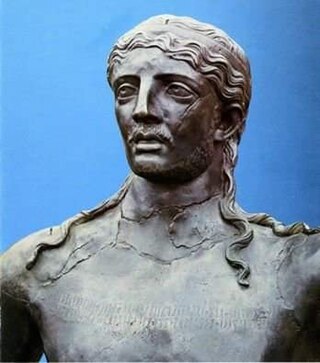
Muzayqiya, real name 'Amr was the leader of the Azd tribes and a king ruling parts of Yemen in the 2nd century CE. Muzayqiya succeeded his brother Imran in the leadership of the kingdom. During his time, the Ma'rib Dam collapsed which resulted in several Qahtanite tribes emigrating from Yemen.












